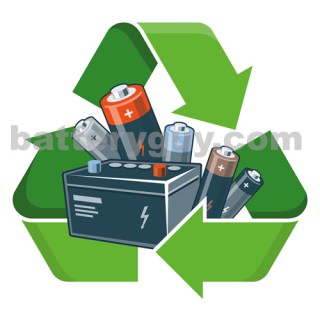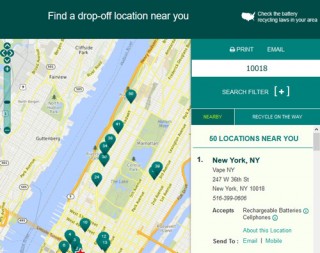Legal responsibilities with used batteries
At the moment there are a mix of nation wide and state specific laws that surround the recycling of batteries with differing responsibilities for individuals and businesses. However, if you simply make it your objective to recycle all of your used batteries then you can be confident that you have met your legal responsibilities.
This article explains how to do just that.
Common household and office battery recycling – collection points
 Most batteries that you might use around the home or in the office can be easily recycled or disposed of in an environmentally friendly way via multiple collection points across the United States.
Most batteries that you might use around the home or in the office can be easily recycled or disposed of in an environmentally friendly way via multiple collection points across the United States.
- Call2Recycle (www.call2recycle.org/locator) – offers an online resource for locating a collection point near you and their search results can be filtered to identify places that take disposable, rechargeable or cell phone batteries.
- Earth911 (search.earth911.com) – maintains a nation wide searchable database of places that collect batteries as well as other products and materials. To make sure you find the right place you will need to know your battery chemistry (lithium, alkaline, etc.) which is usually written on the label.
- Shopping malls and electrical shops – often have collection boxes for small every day batteries.
- Cell phone retailers – as with shopping malls cell phone retailers often accept used cell phone batteries. In New York and California they are legally required to do so.
Common household and office battery recycling – pickup services

Call2Recycle (www.call2recycle.org/locator) has a nationwide pickup service for used batteries if you can’t get to a collection point yourself. Through this service you can recycle or dispose of:
- Lithium-Ion, Nickel Metal Hydride, Nickel Zinc and Nickel Cadmium rechargeable batteries up to 11 lbs (5 kg) in weight at no charge
- Sealed Lead Acid (SLA) rechargeable batteries up to 25 lbs (11 kg) in weight at no charge
- Alkaline and lithium disposable batteries. Note for these types there may be a charge.
Recycling vehicle, wet cell and flooded lead acid batteries
Wet cell refers to batteries that contain electrolyte in liquid form and the most common of these is the flooded lead acid battery used as a starter battery in many gasoline and diesel vehicles.
Note there are many types of lead acid batteries beyond the ‘flooded’ type which are known as sealed lead acid batteries and some are used as starter batteries. These fall into two categories:
- Absorbent Glass Mat (AGM) – uses an acid soaked mat as the electrolyte and so is considered a Sealed Lead Acid
- Gel – uses a silicon as the electrolyte and so is also considered Sealed Lead Acid
As such, check the labeling on the battery carefully because Sealed Lead Acid (SLA) batteries can be disposed of with other household or office batteries through the methods covered earlier in this article but these same programs won’t accept wet cell or flooded units.
This isn’t because wet cell or flooded batteries are difficult or expensive to recycle, ironically they are one of the more profitable types. The issue is in the highly corrosive acid which can easily leak out and cause extensive damage.
However, wet cell retailers such as garages and superstores often accept used units as they already have the appropriate transport to get new batteries to them so they can use also use it to move spent batteries back through the supply chain.
Check with local garages and vehicle battery retailers in your area and you are highly likely to find one who will accept your old unit for recycling.
Sending batteries for recycling by post
Some collection or recycling facilities (see above for references on how to find these) will accept batteries sent by post and are often flagged as ‘In Mail’ options. In almost all cases they will expect you to pay the postage costs.
Before sending however make sure of the following:
- Remember just because a battery can no longer power a particular appliance does not mean it has no power. Each battery should be packed in a way that ensures the terminals cannot short out either by touching the edge of a metal container or by coming into contact with other units. Shorting out could cause even a battery with a small charge to over heat, catch fire or explode.
- Do not send damaged batteries. Internal corrosive liquids can leak during shipping and there is also the potential of batteries with some power still in them to short out and catch fire.
- Do not send Lithium batteries using air transport services. Regulations regarding the sending of lithium-ion by air are highly complex and restrictive so use ground shipping services or you may find your battery is simply returned to your doorstep. See Shipping lithium batteries for the full low down on this.
Commercial batteries and large volume battery recycling
 How all waste batteries are handled (not just those suitable for recycling) on a larger scale is governed by the Environmental Protection Agency and the Department of Environmental Quality. Their roles and the regulations in general were updated in 1996 with the Mercury Containing Rechargeable Battery Management Act.
How all waste batteries are handled (not just those suitable for recycling) on a larger scale is governed by the Environmental Protection Agency and the Department of Environmental Quality. Their roles and the regulations in general were updated in 1996 with the Mercury Containing Rechargeable Battery Management Act.
Generally referred to as the ‘Battery Act’ it actually goes far beyond mercury issues and covers how a large number of battery types should be disposed of or recycled.
Definitions and rules are defined in the Code of Federal Regulations Title 40 Part 273: Protection of the Environment which covers a large number of products and materials. Hence it refers to batteries as part of ‘Universal Waste‘, a term which also includes a wide variety of items from lamps to pesticides.
They define two types of waste handlers:
- Those who have less than 5,000 kilograms of Universal Waste at any one time – known as a Small Quantity Handler of Universal Waste.
- Those who have more than 5,000 kilograms of Universal Waste at any one time – known as Large Quantity Handler of Universal Waste.
Note you do not need to apply for one of these designations. You automatically become one if you meet the terms above and bear in mind that ‘Universal Waste‘ includes far more than just batteries. Should this happen then by default you are subject to the regulations.
For medium to large businesses that need to dispose of items such as batteries on a frequent basis it is worth taking professional legal advice to see if you would fall into either of the above categories, and if so, check that you meet the standards needed to comply with current legislation.
Frequently asked battery recycling questions
Why is there a charge to recycle some battery types?
There are well over a dozen different types of ways batteries are constructed. Various types of metals and chemical solutions inside a battery give it different properties such as how many times it can recharge, how long it will last when not in use, etc. etc.
Some of these metals (like lead in lead acid batteries) are expensive and so it makes sense to take back old batteries, strip out the valuable materials and use them to manufacture new units. In the US 97% of lead acid batteries are now recycled primarily for this reason.
With other metals it works out cheaper (rightly or wrongly) to mine them from natural resources rather than getting them out of old batteries. However, many of these metals are highly toxic and if disposed of with normal household waste end up causing environmental damage.
Nickel Cadmium is the leading culprit here, where the cadmium can poison natural water supplies, but many other chemistries can also have damaging effects.
No one has a commercial interest in collecting these batteries, so in order to make sure they are disposed of properly you may have to pay for or contribute to the costs depending on the State in which you live.
Are all batteries recyclable?
No. Much depends on the types of metals used in the battery structure. Lead is highly recyclable and about half of the lead used during the manufacture of new units comes from old batteries. Nickel Cadmium on the other hand is too expensive to strip out and use again.
However, for simplicity, most organizations (such as earth911 and call2recycle) simply call their schemes ‘recycling’ even though many of the units returned will actually be disposed of. The key is that they will be disposed of safely which means actively taking part in these programs is still better than throwing these batteries out with your household waste where they can cause environmental damage.
It is for this reason that some recycling services are offered free while others may incur a charge.
Is the recycling process environmentally friendly?
This is a slightly tricky one to answer as it depends how you look at it. Getting metals and materials out of a finished product is often more difficult and energy intensive than simply mining them out of the ground. Sometimes up to ten times more energy can be used in order to recycle which on its own makes it sound like it isn’t the most environmentally sound option.
However, mining as an activity has different impacts in the environments they operate – disturbing natural habitats, unsightly open cast projects, slag heaps from waste, etc. In this sense there is more to be said for recycling.
Furthermore, without a recycling process there would also need to be more land fill space and potentially more hazardous materials would be buried there polluting areas, creating un-farmable land and posing possible threats to water supplies
In the US, tariffs are imposed on some imports of metals specifically to drive up their prices so that recycling becomes the best option commercially. For many battery types, assessing which batteries are made from recycled material verses one made from freshly mined material and which one has the smaller carbon foot print can be highly debatable. .
Is battery recycling a profitable business?
Since the early 1900s there has been money to be made in recovering lead acid batteries (primarily used as engine starters in vehicles) due to the high cost of purchasing raw lead and the relative ease with which lead can be extracted from spent batteries.
Driven by our ever greater consumption needs for portable electronic devices and stricter regulations about how batteries can be disposed,the battery recycling industry has boomed in recent years. Higher import tariffs on raw materials needed for battery manufacturing are also part of the drive aimed at making us reuse the metals in old units.
The Environmental Protection Agency estimates that for lead acid batteries alone the number recycled has more than doubled from under 30,000 units in 1998 to 70,000 units in 2015.
On the surface, that might seem to make this sector an ideal one for entrepreneurs or investors in search of profit, but in reality almost all battery recycling is loss making (with the exception of lead acid) and requires subsidies.
There are two key reasons for this:
- many modern battery designs require pure grades of metals and the refining process of recycling is long, energy intensive and costly when compared to simply digging them out of the ground, even when import tariffs are taken into account.
- a large number of batteries that we use today are tiny or the internal components are microscopically thin, so extracting individual materials is physically difficult.
There are hopes that as volumes increase further, the economies of scale will make the recycling of all battery types more viable, but we are not there yet.


Leave A Comment?